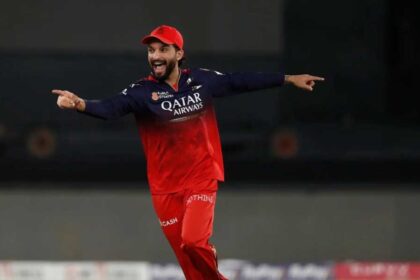There’s a nonchalance about Hardik Pandya when he hits his trademark no-look sixes; his timing, skill and power make it look easy. Aiding the star in clearing the rope is his bat with a curve in the front – a radical innovation that has been around for a while now but has largely gone unnoticed.
The revolutionary ‘bat tweak’ originated in the 1990s when came up with a query for his bat manufacturer. He had noticed that his bats would develop a nice sweet spot – the wood would get compressed, giving the willow a ‘good dent’ – when used over a period of time. ‘Was it possible to have a readymade sweet spot?’ was Tendulkar’s question. And the answer was ‘yes’ and the bats were no longer flat as a chopping board. They were also convex.
With time, the dent got deeper and broader and the process more scientific. Researchers would bank on the laws of physics, carve the bat keeping in mind the principles of the angle of incidence and reflection. The result is constantly evolving game-changing cricket equipment that is silently and methodically putting cricket on steroids, making six-hitting a frequent event. The ‘bats with arc’ are T20’s unsung heroes, the anonymous crowd-pullers.
Hardik’s skills, his training, aided by his bat, make him a front-runner in the arms race among six-hitters. His bat has nearly 200 percent more curve than the competition, claims Meerut-based manufacturer Sanspareils Greenlands (SG).
Behind the scenes, in this drive to stay ahead, is a collaboration between researchers at the Indian Institute of Technology, , mechanical engineers at SG, and Hardik himself. It isn’t unusual for the India star to travel to Meerut and ask questions, and give suggestions, to the engineers poring through bat dimensions.
Hardik has a couple of demands: the ball hitting the curve’s sweet spot, and its take-off being at the precise angle that would make it travel the farthest. As an SG engineer points out, it is all physics. For the trajectory of the ball to make a perfect parabola in the air, and thus cover the longest distance, the take-off from the bat needs to be at 45 degrees. With a curved willow, the batsman’s chance of getting the ideal angle increases.
SG CEO Paras Anand gives a golf analogy to explain his bat with an arc.
“If you look at golf clubs, the pitching wedge has an angle and gives you elevation. What we have done with the help of the curve is give a very good angle. A 45-degree hit with the right force takes it almost 90 metres. That is the science here. The curve helps loft the ball. Hardik figured that out,” Anand said.
Curve and sweet spot link
The SG engineers scribble diagrams on their notebooks and take help of 3D animation on their laptops to explain the mechanics behind their Arc series bat. Few are old-timers having spent over a decade at the company and aren’t keen to be named. In a highly-competitive market, they are assets that the company can’t afford to identify or lose.
Listening to them makes one understand why T20 cricket has become a batsman’s game. They talk about how by increasing the degree of the curve, the surface of the bat gets longer and the sweet spot bigger.
“A bat with a longitudinal curve has a longer surface if you measure along the curve, like with a string, compared to a flat bat. Because of this extra surface area, the sweet spot or the high-performing zone becomes bigger. This means the bat has more ‘forgiving space’ to hit the ball well, even if the timing isn’t perfect. So, curving the bat helps increase the area where you get powerful, clean shots,” a mechanical engineer, who is Hardik’s sounding board, says.
The curve, as compared to a flat surface, makes the bat a better tool for a batsman, but execution of big hits requires exemplary skill. Digging out yorkers, in a batsman-friendly game, has also become easier.
“A flat bat sends the ball in a straight line. But a curved bat helps lift the ball better because of the angle it creates when the ball hits it. This can be useful in hitting sixes, especially when playing shots like scoops or hitting yorkers. The curve helps improve the launch angle of the ball… around 45 degrees is usually ideal for distance,” the engineer explains.
There’s a catch. The curve can result in an uppish cover drive. Anand brushes off the fears of a batsman getting caught in the circle. “It is not that the ball won’t go along the ground. The chances of getting caught are not that high,” Paras says. Then he delivers the punchline. “Ultimately, they all want to hit sixes. chhakka hi marna hai.”
The latest curved bats are machine-made but finished by hand to ensure that the weight is exactly what top players like Hardik want. “Only a machine can get the curve accurate to the degree that Hardik wants. It is that specific,” Anand says.
SG’s latest series of curved bats were launched in the market in December. To democratise six-hitting, Hardik insisted the curved blade bats be -friendly. The starting price is Rs 12,000, going up to Rs 60,000 for the top end. Customised bats for top cricketers creep towards the six-figure mark.
“Last two or three years, we have been doing a lot of work. To have that curve at a mass scale needed a lot of R&D. We started by doing less than 100 bats a day, now we have the capacity for 1,200 bats a day. The plan is, if we have to produce 5,000 bats per day in the next two to three years, we should be able to do it. We have placed orders for machines and expect growth in the market,” Anand said.
Tendulkar, an early mover
While talking about the history of bat-making, Paras goes back to the Tendulkar era. “What used to happen with the old bats was that you kept playing and because the ball used to keep hitting the bat, a slight depression formed on the blade. Sachin got fascinated by that. Because he played so much, there was more compression over a period of time. Once you keep playing, the rebound improves.
“It’s like a sweet spot being created. What was happening was automatic pressing at a very slow pace. He was probably the first one who picked out his old bat and said he wanted the same curve in the new bat. He was pushing bat manufacturers. When the Australians came to India in 2001, they were curious as to how Sachin had a bow in his bat,” Anand recalled.
The early versions of the curved bats were created using jugaad (makeshift technology); clamping down bats overnight to make the wood flex. But the science behind the effectiveness of a curve in a bat is only being explored now, by players as well as bat manufacturers.
A 100-metre walk within the SG factory can narrate the story of cricket bats’ size from S to XL. Just beyond the reception area, is a showcase and photo-wall with black and white images of Tendulkar, and Sunil Gavaskar, the batsman who made SG a household name.
An old English willow Sunny Tonny bat on display catches the eye, for the lovely grain on the wood and because of the edge or the smallness of it. A floor up is an enclosed room at the end of the hallway, where a skilled worker is shaving off wood from a ‘ sample bat’ before putting it on a digital weighing scale. The finishing touches are being given to his bats.
Paras rewinds to the playing days of Gavaskar to contrast two bat-manufacturing eras. The original story was told by his uncle.
“We used to give Gavaskar two bats, and he used to play the full season with them. After six months, he would come back and say this one was good and this one not so good. Two bats for the season. If a bat broke, we would send a replacement, but there again he would have no say.”
To the naked eye, Hardik’s bat is as thick as at least two Sunny Tonnys. Keep the two willows separated by decades face down and spine up next to each other. They look like two athletes – one lying flat, the other doing push-ups.
The SG factory is a place buzzing with activity. The engineers lead the way to the dispatch department where the bats are being packed. The bats with prominent arcs wait to be loaded on trucks. The engineer picks one of the shining willows and asks for a wooden hammer.
“Bats are like a tabla, they have an area of percussion and its centre,” he says as he bangs the hammer on the bat. When he hits the sweet spot, it makes a sound that is music to a batsman. It’s the one that Hardik hears when the ball hits the centre point of his bat’s area of percussion. Once that magical ping hits his ears, he doesn’t bother to check the flight of the ball. The no-look six.
Why a bat with curve helps six-hitting
The sweet spot
The centre of mass is the point where the bat is perfectly balanced. So if you place your finger there, the bat wouldn’t tip either way. The center of percussion is slightly below the center of mass. When the ball hits this point, the bat doesn’t shake in a batsman’s hands and most of the energy goes into the ball. This makes the ball travel farther. The centre of percussion and the area just around it is known as the sweet spot.
Advantages of a curved bat
A bat with a curve has a longer surface than a flat one. The difference can be measured with a string run along the curve. Because of this extra surface area, the sweet spot becomes larger.
The 45 degree angle
To hit a six, it helps if the ball leaves the bat at an angle — 45 degrees is ideal. A flat bat sends the ball in a straight line. But a curved bat helps give an angled lift to the ball. The curve also helps to scoop out yorkers.






